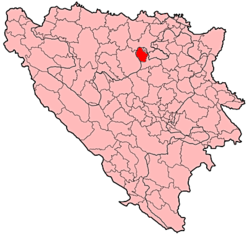Tešanj
|
Tešanj Тешањ |
||
|---|---|---|

Heart of the Old town of Tešanj as seen from the castle
|
||
|
||
 Location of Tešanj within Bosnia and Herzegovina. |
||
| Location of Tešanj | ||
| Coordinates: 44°36′51.5″N 17°59′22.1″E / 44.614306°N 17.989472°E | ||
| Country | Bosnia and Herzegovina | |
| Government | ||
| • Municipality president | Suad Huskic (SDA) | |
| Area | ||
| • Total | 155,9 km2 (602 sq mi) | |
| Population (2013 census) | ||
| • Total | 46,135 | |
| • Density | 296/km2 (770/sq mi) | |
| Time zone | CET (UTC+1) | |
| • Summer (DST) | CEST (UTC+2) | |
| Area code(s) | +387 32 | |
| Website | http://www.opcina-tesanj.ba | |
Tešanj is a town and municipality in the northern part of Bosnia and Herzegovina, located near Teslić, Doboj and Zavidovići. Administratively, it belongs to the Zenica-Doboj Canton of the Federation of Bosnia and Herzegovina.
Tešanj is located at an altitude of 230 meters and developed around the river Tešanjka.
The present name of the city was mentioned for the first time in 1461 in a charter from King Stephen Tomašević to his uncle Radivoj. The charter stated that King Stephen Tomašević grants him, among other possessions "i na Usori grad Tešanj -- the city of Tešanj, in the Usora region".
Between the second half of the 15th century and the first half of the 16th century, the history of Tešanj was rather chaotic. Since Bosnia was considered a buffer state by the Ottomans, it changed rulers quite often, alternating between Ottoman and Hungarian occupation. Between 1463 and 1476 Tešanj was the center of the Bosnian kingdom and the residence of Duke Radivoj Kotromanić.
From 1512 (or 1520-21) on, Tešanj was under continuous rule of the Ottoman Empire. The most Ottoman influential ruler of Tešanj was the Bosnian Sandžak-bey Gazi Ferhad-bey. It was under his authority that the city rapidly developed. His most significant contribution was the Ferhadija Mosque (1563), which still stands in the old town, dating back to the 16th century. Gazi Ferhad-bey died in 1568 and was buried in the yard of the mosque. The epitaph on his tombstone was in Arabic, and is the oldest Islamic record in Tešanj.
The old Eminagić House is the oldest house in Tešanj, still standing the test of time, and is said to have been built at the end of the 17th century.
The Old Town is dominated by the well-preserved fortress, called "Gradina", that overlooks the entire city. The Upper City Center expands around the castle, rather on the bottom of this castle. Very early this castle became a center of economic and cultural life of Tešanj. This was developed along with retail and trade in Tešanj. The city center developed rapidly in the 17th and 18th century, when there were around 40 stores and trades operating.
...
Wikipedia


